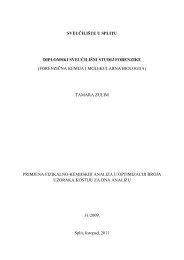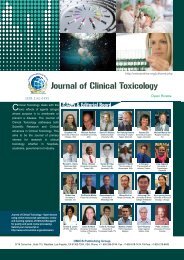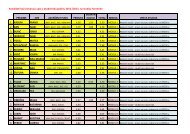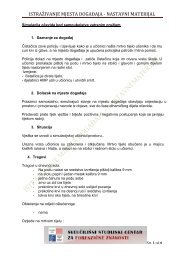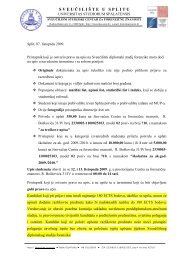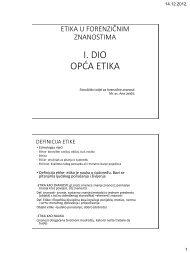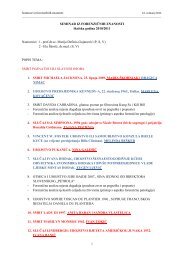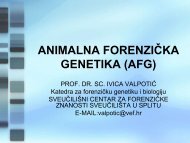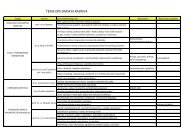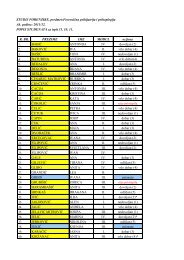The Individualization Fallacy in Forensic Science Evidence
The Individualization Fallacy in Forensic Science Evidence
The Individualization Fallacy in Forensic Science Evidence
You also want an ePaper? Increase the reach of your titles
YUMPU automatically turns print PDFs into web optimized ePapers that Google loves.
<strong>The</strong> <strong>Individualization</strong> <strong>Fallacy</strong> <strong>in</strong><strong>Forensic</strong> <strong>Science</strong> <strong>Evidence</strong>Michael J. Saks * & Jonathan J. Koehler **I. FOREWORD: THE TWO STEPS IN FORENSICIDENTIFICATION .................................................................. 199II. THE INDIVIDUALIZATION FALLACY ...................................... 203A. Reliance on the Notion of <strong>Individualization</strong> ........... 205B. Orig<strong>in</strong>s and Evolution of theNotion of <strong>Individualization</strong> ..................................... 207III. UNPROVED AND PERHAPS UNPROVABLE.............................. 208IV. OLD NEWS ........................................................................... 214V. WHAT TO DO ........................................................................ 216A. <strong>The</strong> Present .............................................................. 216B. <strong>The</strong> Future ............................................................... 217VI. CONCLUSION........................................................................ 218I. FOREWORD: THE TWO STEPS IN FORENSIC IDENTIFICATION<strong>Forensic</strong> identification science <strong>in</strong>volves two fundamental steps.<strong>The</strong> first step is to compare a questioned item of evidence to anexemplar from a known source and judge whether they appear so alikethat they can be said to match. <strong>The</strong> second step is to assess themean<strong>in</strong>g of that reported match: What is the probability that thequestioned and the known orig<strong>in</strong>ated from the same source? 1* Professor of Law, Professor of Psychology, and Fellow of the Center for the Study ofLaw, <strong>Science</strong>, and Technology, Sandra Day O’Connor College of Law, Arizona State University.Ph.D. 1975, Ohio State University; M.S.L. 1985, Yale Law School.** Professor of Law, Sandra Day O’Connor College of Law and W.P. Carey School ofBus<strong>in</strong>ess, Arizona State University. Ph.D. 1989, University of Chicago.1. From an evidentiary value perspective, the two steps that we identify might be referredto as “reliability” and “diagnosticity,” respectively. See generally DAVID A. SCHUM, EVIDENTIALFOUNDATIONS OF PROBABILISTIC REASONING (1994). <strong>The</strong> first step <strong>in</strong>volves the reliability of theevidence because it concerns the value of the expert’s testimony for establish<strong>in</strong>g that thequestioned and the known samples do, <strong>in</strong> fact, share characteristics. <strong>The</strong> second step <strong>in</strong>volves thediagnosticity of the evidence because it concerns the value of the match conclusion for draw<strong>in</strong>gan <strong>in</strong>ference that the questioned and known samples share a common source.199
200 VANDERBILT LAW REVIEW [Vol. 61:1:199Different risks of error are present at each step. <strong>The</strong> risk oferror <strong>in</strong> the first step is that a reported match between a questionedand a known sample might not really match. Even if the method usedto compare questioned and known samples were flawless, an errorcould occur if, for example, one of the samples had been mislabeled ormixed up with a different sample. <strong>The</strong> risk of error associated with thesecond step is that, while accurate, the reported match may havearisen through co<strong>in</strong>cidence and not because the samples share acommon source. <strong>The</strong> risks of error at both steps affect the ultimate<strong>in</strong>ferences that can be drawn about the identification evidence <strong>in</strong> acase. 2Both risks are subjects of far too little research. As to the firststep, exist<strong>in</strong>g standards and procedures do not provide sufficientprotection from erroneous conclusions that two marks are<strong>in</strong>dist<strong>in</strong>guishably alike—that is, that they “match” when <strong>in</strong> fact theydiffer. Few, if any, crim<strong>in</strong>alistics subfields have objective standards fordecid<strong>in</strong>g whether two patterns match. That determ<strong>in</strong>ation is left tothe judgment of each exam<strong>in</strong>er. For example, consider David Stoney’sdiscussion of f<strong>in</strong>gerpr<strong>in</strong>t exam<strong>in</strong>ation standards:How much correspondence between two f<strong>in</strong>gerpr<strong>in</strong>ts is sufficient to conclude that they[are the same pattern] . . . ? An adequate answer . . . is not currently available. <strong>The</strong> bestanswer at present . . . is that this is up to the <strong>in</strong>dividual expert f<strong>in</strong>gerpr<strong>in</strong>t exam<strong>in</strong>er todeterm<strong>in</strong>e, based on that exam<strong>in</strong>er’s tra<strong>in</strong><strong>in</strong>g, skill, and experience. Thus, we have anill-def<strong>in</strong>ed, flexible, and explicitly subjective criterion for establish<strong>in</strong>g f<strong>in</strong>gerpr<strong>in</strong>tidentification . . . . Any unbiased, <strong>in</strong>telligent assessment of f<strong>in</strong>gerpr<strong>in</strong>t identificationpractices today reveals that there are, <strong>in</strong> reality, no standards. 3<strong>The</strong> lack of objective standards helps expla<strong>in</strong> the disturb<strong>in</strong>gf<strong>in</strong>d<strong>in</strong>gs from the small body of research that has been conducted onpattern match<strong>in</strong>g by forensic scientists. In some tests, exam<strong>in</strong>ersdisagreed with one another about whether various images matched. 4In others, exam<strong>in</strong>ers who agreed that two patterns matched disagreed2. See Jonathan J. Koehler et al., <strong>The</strong> Random Match Probability (RMP) <strong>in</strong> DNA <strong>Evidence</strong>:Irrelevant and Prejudicial?, 35 JURIMETRICS J. 201, 215-16 (1995) (argu<strong>in</strong>g that the <strong>in</strong>ferentiallimits of a reported match depend more on the risk of error at the first step when the risk of aco<strong>in</strong>cidental match is very low).3. David A. Stoney, Measurement of F<strong>in</strong>gerpr<strong>in</strong>t Individuality, <strong>in</strong> ADVANCES INFINGERPRINT TECHNOLOGY 327, 329 (Henry C. Lee & Robert E. Gaensslen eds., 2d ed. 2001).4. See, e.g., Jodi Sita et al., <strong>Forensic</strong> Handwrit<strong>in</strong>g Exam<strong>in</strong>ers’ Expertise for SignatureComparison, 47 J. FORENSIC SCI. 1117, 1119 (2002) (f<strong>in</strong>d<strong>in</strong>g <strong>in</strong>correct op<strong>in</strong>ions even amongexperienced handwrit<strong>in</strong>g analysts); John I. Thornton & Joseph L. Peterson, <strong>The</strong> GeneralAssumptions and Rationale of <strong>Forensic</strong> Identification, <strong>in</strong> 4 MODERN SCIENTIFIC EVIDENCE: THELAW AND SCIENCE OF EXPERT TESTIMONY 1, 9 (David L. Faigman et al. eds., 2006-2007 ed. 2006);Collaborative Test<strong>in</strong>g Service, <strong>Forensic</strong> Test<strong>in</strong>g Program, http://www.collaborativetest<strong>in</strong>g.com/forensics/report_list.html (various fields, various years).
2008] FORENSIC EVIDENCE 201(sometimes dramatically) on what constituted the match. 5 Exam<strong>in</strong>ersdiffer not only <strong>in</strong> their ability to perceive pattern similarity, but also<strong>in</strong> their thresholds for declar<strong>in</strong>g matches. 6Other research suggests that the match judgments ofexperienced crim<strong>in</strong>alists are <strong>in</strong>fluenced by extraneous <strong>in</strong>formation. Astudy by Itel Dror et al. found that four of five f<strong>in</strong>gerpr<strong>in</strong>t experts whopreviously had identified two pr<strong>in</strong>ts as a match reached differentconclusions on a later exam<strong>in</strong>ation, after they learned that the pr<strong>in</strong>tswere from different persons. 7 In a follow-up study, six otherf<strong>in</strong>gerpr<strong>in</strong>t experts were provided with eight pairs of pr<strong>in</strong>ts that theypreviously had judged. 8 <strong>The</strong> study found that <strong>in</strong>troduction ofcontextual <strong>in</strong>formation <strong>in</strong>duced four of the six experts to change atleast one of their previous match judgments. Some pairs that werejudged to be exclusions subsequently were judged to be matches, andvice-versa. Surpris<strong>in</strong>gly, some experts made <strong>in</strong>consistent decisions <strong>in</strong>the control condition where contextual <strong>in</strong>formation was not <strong>in</strong>troduced(thus reflect<strong>in</strong>g random, and not systematic, error). <strong>The</strong>se resultssuggest that crim<strong>in</strong>alists should employ the same k<strong>in</strong>d of bl<strong>in</strong>dexam<strong>in</strong>ation procedures that are used widely <strong>in</strong> other fields. 9 Such5. I.W. Evett & R.L. Williams, A Review of the Sixteen Po<strong>in</strong>ts F<strong>in</strong>gerpr<strong>in</strong>t Standard <strong>in</strong>England and Wales, 46 J. FORENSIC IDENTIFICATION 49, 59 (1996) (f<strong>in</strong>d<strong>in</strong>g that althoughexam<strong>in</strong>ers agreed that two f<strong>in</strong>gerpr<strong>in</strong>ts matched, for one pair of pr<strong>in</strong>ts some exam<strong>in</strong>ers believedthey saw as few as ten po<strong>in</strong>ts of agreement and others as many as forty; for another pair ofpr<strong>in</strong>ts some exam<strong>in</strong>ers saw as few as fourteen po<strong>in</strong>ts of agreement and others as many as fiftysix;and so on).6. Victoria Phillips et al., <strong>The</strong> Application of Signal Detection <strong>The</strong>ory to Decision-Mak<strong>in</strong>g<strong>in</strong> <strong>Forensic</strong> <strong>Science</strong>, 46 J. FORENSIC SCI. 294, 300-01 (2001).7. Itiel E. Dror et al., Contextual Information Renders Experts Vulnerable to Mak<strong>in</strong>gErroneous Identifications, 156 FORENSIC SCI. INT’L 74, 76 (2006).8. Itiel E. Dror & David Charlton, Why Experts Make Errors, 56 J. FORENSICIDENTIFICATION 600, 610 (2006).9. D. Michael Ris<strong>in</strong>ger et al., <strong>The</strong> Daubert/Kumho Implications of Observer Effects <strong>in</strong><strong>Forensic</strong> <strong>Science</strong>: Hidden Problems of Expectation and Suggestion, 90 CAL. L. REV. 1, 45-46(2002). <strong>The</strong> phrase “bl<strong>in</strong>d exam<strong>in</strong>ation procedures” can have more than one mean<strong>in</strong>g. Here, weuse the term to refer to bl<strong>in</strong>dness or lack of knowledge about facts of the target case or the beliefsof other <strong>in</strong>vestigative or prosecutorial personnel. Such contextual bl<strong>in</strong>dness helps ensure thatanalysts base their conclusions on the forensic science evidence alone. Bl<strong>in</strong>d exam<strong>in</strong>ation canalso refer to a test<strong>in</strong>g situation <strong>in</strong> which the analysts who are asked to determ<strong>in</strong>e whether two ormore specimens, pr<strong>in</strong>ts, mark<strong>in</strong>gs, etc. match are unaware that they are be<strong>in</strong>g tested. Acrossvarious forensic fields, the data <strong>in</strong>dicate that analysts’ performance improves when the analystsknow that they are be<strong>in</strong>g tested. Joseph L. Peterson et al., <strong>The</strong> Feasibility of External Bl<strong>in</strong>d DNAProficiency Test<strong>in</strong>g. I. Background and F<strong>in</strong>d<strong>in</strong>gs, 48 J. FORENSIC SCI. 21, 26-27 (2003).Presumably, analysts behave more vigilantly when they know there are be<strong>in</strong>g evaluated. This iswhy we and many others believe that casework accuracy rates <strong>in</strong> the forensic sciences would bemore accurate if measured by performance on proficiency tests <strong>in</strong> which exam<strong>in</strong>ers do not knowthey are be<strong>in</strong>g tested. Michael J. Saks & Jonathan J. Koehler, <strong>The</strong> Com<strong>in</strong>g Paradigm Shift <strong>in</strong><strong>Forensic</strong> Identification <strong>Science</strong>, 309 SCIENCE 892, 893-94 (2005).
202 VANDERBILT LAW REVIEW [Vol. 61:1:199procedures would protect first-stage judgments from the contextual<strong>in</strong>fluences that contribute to errors. 10As Itiel Dror and David Charlton po<strong>in</strong>t out, “How rare andunder what conditions errors occur at a practical level is still unclearat this stage.” 11 One reason for this knowledge gap is the dearth ofhigh quality proficiency tests across the various discipl<strong>in</strong>es. Such testsshould be closed (i.e., the analyst is bl<strong>in</strong>d to the fact that the testmaterials are not part of ord<strong>in</strong>ary case work), be external (i.e.,adm<strong>in</strong>istered by a dis<strong>in</strong>terested party), and use realistic case samples.Unfortunately, proficiency tests that <strong>in</strong>clude all three <strong>in</strong>gredients arevirtually nonexistent. On one hand, results from the proficiency teststhat have been conducted sometimes reveal disturb<strong>in</strong>gly high errorrates. On the other hand, performance on proficiency tests likelyoverestimates performance <strong>in</strong> actual casework because the tests areopen, tend to be relatively easy, and lack the bias<strong>in</strong>g contextual<strong>in</strong>formation that is available <strong>in</strong> much real casework. 12 Althoughforensic science leaders, on occasion, have declared errors to be sofrequent as to be “unacceptable,” 13 the fact that errors occur with someregularity signals that a reported match between a pair of mark<strong>in</strong>gsprobably has less probative value than exam<strong>in</strong>ers claim or than judgesand juries assume.Popular television programs such as CSI 14 and <strong>Forensic</strong> Files 15re<strong>in</strong>force the notion of <strong>in</strong>dividualization <strong>in</strong> the collective publicimag<strong>in</strong>ation by offer<strong>in</strong>g confident pronouncements from scientistsabout whose hair was recovered from the knife or which gun fired themurderous bullet. But can forensic science really make such exactdeterm<strong>in</strong>ations? Can forensic scientists be sure that a particularhammer, to the exclusion of all other hammers <strong>in</strong> the world, producedthe impr<strong>in</strong>ts observed on a victim’s body? <strong>The</strong> concept of<strong>in</strong>dividualization, which lies at the core of numerous forensic sciencesubfields, exists only <strong>in</strong> a metaphysical or rhetorical sense. <strong>The</strong>re is noscientific basis for the <strong>in</strong>dividualization claims <strong>in</strong> forensic sciences.Part II of this Essay expla<strong>in</strong>s what we mean by the term“<strong>in</strong>dividualization fallacy” and describes the orig<strong>in</strong>s of<strong>in</strong>dividualization <strong>in</strong> crim<strong>in</strong>alistics. Part III critically exam<strong>in</strong>es thearguments offered <strong>in</strong> support of the <strong>in</strong>dividualization hypothesis. This10. Robert B. Stacey, Report on the Erroneous F<strong>in</strong>gerpr<strong>in</strong>t <strong>Individualization</strong> <strong>in</strong> the MadridTra<strong>in</strong> Bomb<strong>in</strong>g Case, 54 J. FORENSIC IDENTIFICATION 706, 715 (2004).11. Dror & Charlton, supra note 8, at 614.12. Saks & Koehler, supra note 9, at 895.13. David L. Grieve, Possession of Truth, 46 J. FORENSIC IDENTIFICATION 521, 524 (1996).14. CSI: Crime Scene Investigation (NBC television broadcast 2000-present).15. <strong>Forensic</strong> Files (Court TV television broadcast 2000-present).
2008] FORENSIC EVIDENCE 203Part also addresses the second step <strong>in</strong> forensic identification: What<strong>in</strong>ferences can be drawn from a forensic scientist’s conclusion that anexemplar (such as a partial f<strong>in</strong>gerpr<strong>in</strong>t, handwrit<strong>in</strong>g sample, ortirepr<strong>in</strong>t) matches a known source? <strong>Forensic</strong> scientists across a broadarray of sub-specialties long have ma<strong>in</strong>ta<strong>in</strong>ed that such a f<strong>in</strong>d<strong>in</strong>g issynonymous with a conclusion that the exemplar mark<strong>in</strong>g is producedby the known source. Part IV gives a historical account of scientistswho have recognized the problem of <strong>in</strong>dividualization <strong>in</strong> forensicscience. Part V offers suggestions for ways to improve the scientificfoundation of identification <strong>in</strong> crim<strong>in</strong>alistics. F<strong>in</strong>ally, Part VIconcludes that forensic scientists must provide sound evidence fortheir conclusions and should avoid exaggerat<strong>in</strong>g their results.II. THE INDIVIDUALIZATION FALLACYIn his recent book on DNA typ<strong>in</strong>g, David Bald<strong>in</strong>g expla<strong>in</strong>swhat he terms “the uniqueness fallacy.” 16 Attorneys, judges, andexperts commit this fallacy <strong>in</strong> cases <strong>in</strong>volv<strong>in</strong>g DNA evidence whenthey assume that a set of genetic markers that is expected to occurless than once per five billion people (a denom<strong>in</strong>ator that roughlyequals the earth’s population) must be unique. An illustration isprovided by the follow<strong>in</strong>g argument offered <strong>in</strong> the O.J. Simpsonmurder trial:[L]adies and gentlemen, his blood on the rear gate with that match, that makes him one<strong>in</strong> 57 billion people that could have left that blood, I mean there is [sic] what, fivemillion [sic] people on the planet, that means you would have to go through 57 billionpeople to f<strong>in</strong>d the DNA profile that matches Mr. Simpson’s. <strong>The</strong>re is [sic] only fivebillion people on the planet. Ladies and gentlemen, that is an identification, okay, thatproves it is his blood. Nobody else’s on the planet; no one. 17Bald<strong>in</strong>g refers to a British case <strong>in</strong> which the appellate judgemade a similar assumption: “I should th<strong>in</strong>k there are not more than27 million males <strong>in</strong> the United K<strong>in</strong>gdom, which means that it isunique.” 18 Likewise, a forensic science textbook states: “Balthazardhas mathematically determ<strong>in</strong>ed that the probability of two <strong>in</strong>dividualshav<strong>in</strong>g the same f<strong>in</strong>gerpr<strong>in</strong>ts is one out of 1 x 10 60 . . . . Thisprobability is so small as to exclude the possibility of any two<strong>in</strong>dividuals hav<strong>in</strong>g the same f<strong>in</strong>gerpr<strong>in</strong>ts.” 19 In yet another example of16. DAVID J. BALDING, WEIGHT-OF-EVIDENCE FOR FORENSIC DNA PROFILES 148 (2005).17. Transcript of Clos<strong>in</strong>g Argument by Ms. Clark at *21, People v. Simpson, No. BA097211,1994 WL 737964 (Cal. Super. Ct. Dec. 15, 1994), 1995 WL 672671.18. R v. Doheny, [1997] 1 Crim. App. 369, 384 (1996).19. RICHARD SAFERSTEIN, CRIMINALISTICS: AN INTRODUCTION TO FORENSIC SCIENCE 73 (9thed. 2007).
204 VANDERBILT LAW REVIEW [Vol. 61:1:199the same faulty logic, Keith Inman and Nora Rud<strong>in</strong> argue that objectsof forensic <strong>in</strong>terest are unique by analogy to the asserted uniquenessof snowflakes, claim<strong>in</strong>g that the number of ways that water moleculescan be arranged <strong>in</strong>to a typical snowflake:is so astronomically larger than the number of snowflakes that have ever existed that itis unreasonable to believe that any one arrangement has occurred more that [sic] once.When a characteristic (or characteristics) of an item can be described <strong>in</strong> such a fashion,it is believed to be unique, with no duplicate on earth. It has then been <strong>in</strong>dividualized. 20Although markers that rarely occur might be unique, it is afallacy to <strong>in</strong>fer uniqueness from profile frequencies simply becausethey are smaller than the number of available objects. A simpleanalogy clarifies this po<strong>in</strong>t: Imag<strong>in</strong>e a mach<strong>in</strong>e that pr<strong>in</strong>ts lotterytickets with numbers 00 through 99. This mach<strong>in</strong>e can pr<strong>in</strong>t onehundred different tickets. Suppose that each of ten customerspurchases one ticket and that the mach<strong>in</strong>e generates ticket numbersat random, with replacement. <strong>The</strong> total number of unique tickets thatcould be sold (one hundred) exceeds the population of customers (ten)by a factor of ten. And yet there is no law of mathematics or naturethat prevents two (or more) customers from be<strong>in</strong>g issued differenttickets bear<strong>in</strong>g the same number. Indeed, the probability of thathappen<strong>in</strong>g is nearly 40%. 21Some people might be surprised by the rather high chance off<strong>in</strong>d<strong>in</strong>g match<strong>in</strong>g lottery tickets <strong>in</strong> this example. Empirical researchdemonstrates that people commit an array of errors when describ<strong>in</strong>gand <strong>in</strong>terpret<strong>in</strong>g probabilistic evidence like DNA random matchprobabilities. 22 Probabilistic reason<strong>in</strong>g is hard, and assign<strong>in</strong>g anappropriate weight to unfamiliar and extreme probabilistic events,20. KEITH INMAN & NORA RUDIN, AN INTRODUCTION TO FORENSIC DNA ANALYSIS 4 (1st ed.1997).21. <strong>The</strong> probability of at least two people shar<strong>in</strong>g a w<strong>in</strong>n<strong>in</strong>g lottery ticket <strong>in</strong> our example is100 x 99 x 98 x ... x 911 − () =1010037. 2%.This computation is similar to that used to solve the famous “birthday problem,” <strong>in</strong> which theprobability that two people <strong>in</strong> a small gather<strong>in</strong>g would have the same birth date is found to befar greater than human <strong>in</strong>tuition would suggest. See Persi Diaconis & Frederick Mosteller,Methods For Study<strong>in</strong>g Co<strong>in</strong>cidences, 84 J. AM. STAT. ASS’N 853, 857 (1989).22. See, e.g., David H. Kaye et al., Statistics <strong>in</strong> the Jury Box: How Jurors Respond toMitochondrial DNA Match Probabilities, J. EMPIRICAL LEG. STUD. (forthcom<strong>in</strong>g), available athttp://ssrn.com/abstract=996134; Jonathan J. Koehler, Error and Exaggeration <strong>in</strong> thePresentation of DNA <strong>Evidence</strong>, 34 JURIMETRICS J. 21 (1993); Jonathan J. Koehler & LauraMacchi, Th<strong>in</strong>k<strong>in</strong>g About Low-Probability Events: An Exemplar Cu<strong>in</strong>g <strong>The</strong>ory, 15 PSYCHOL. SCI.540 (2004).
2008] FORENSIC EVIDENCE 205such as those that occur 0.1% or 0.001% of the time, is particularlychalleng<strong>in</strong>g. Certa<strong>in</strong>ly, a crim<strong>in</strong>alist’s work and a fact-f<strong>in</strong>der’s taskwould be simplified if they could assume that physical evidencereportedly match<strong>in</strong>g a potential source resulted <strong>in</strong> unique andabsolute identification of the source of the evidence. Unfortunately,that is not possible on current knowledge. This is the central po<strong>in</strong>t ofthis Essay. <strong>The</strong> concept of “<strong>in</strong>dividualization,” which lies at the core ofnumerous forensic science subfields, exists only <strong>in</strong> a metaphysical orrhetorical sense. It has no scientific validity, and it is susta<strong>in</strong>edlargely by the faulty logic that equates <strong>in</strong>frequency with uniqueness.We next discuss the implications of this fallacy and offer suggestionsfor how the science and practice of crim<strong>in</strong>alistics might proceed <strong>in</strong> itsabsence.A. Reliance on the Notion of <strong>Individualization</strong><strong>The</strong> “<strong>in</strong>dividualization fallacy,” as we term it, is a morefundamental and more pervasive cous<strong>in</strong> of Bald<strong>in</strong>g’s uniquenessfallacy. Crim<strong>in</strong>alists seek to <strong>in</strong>dividualize crime scene evidence to itsunique source and frequently claim to have achieved <strong>in</strong>dividualization<strong>in</strong> specific <strong>in</strong>stances. <strong>Individualization</strong> has been def<strong>in</strong>ed as “[t]heprocess of plac<strong>in</strong>g an object <strong>in</strong> a unit category that consists of a s<strong>in</strong>gleunit. <strong>Individualization</strong> implies uniqueness.” 23 <strong>Individualization</strong> refersto “absolute specificity and absolute identification.” 24 Thoughoccasionally crim<strong>in</strong>alists are more conservative, for nearly a centurythey clearly and repeatedly have characterized <strong>in</strong>dividualization asfundamental to what they do. “Crim<strong>in</strong>alistics is the science of<strong>in</strong>dividualization.” 25 “<strong>Individualization</strong> is unique to forensic science.” 26“<strong>The</strong> concept of <strong>in</strong>dividualization is clearly central to the considerationof physical evidence. . . . Our belief that uniqueness is both atta<strong>in</strong>ableand existent is central to our work as forensic scientists.” 27 A forensicscience textbook states:<strong>The</strong> major members of the pattern group are f<strong>in</strong>gerpr<strong>in</strong>ts, questioned documents, toolmark, and firearms evidence, and other patterns, such as footwear and tire impressions.This k<strong>in</strong>d of evidence consists of patterns that might be called <strong>in</strong>dividualization23. Thornton & Peterson, supra note 4, at 11.24. David A. Stoney, What Made Us Ever Th<strong>in</strong>k We Could Individualize Us<strong>in</strong>g Statistics?,31 J. FORENSIC SCI. SOC’Y 197, 197 (1991).25. James W. Osterburg, <strong>The</strong> Evaluation of Physical <strong>Evidence</strong> <strong>in</strong> Crim<strong>in</strong>alistics: Subjectiveor Objective Process?, 60 J. CRIM. L. & CRIMINOLOGY 97, 97 (1969).26. PETER R. DE FOREST ET AL., FORENSIC SCIENCE: AN INTRODUCTION TO CRIMINALISTICS 7(1983).27. KEITH INMAN & NORAH RUDIN, PRINCIPLES AND PRACTICE OF CRIMINALISTICS: THEPROFESSION OF FORENSIC SCIENCE 45, 123 (2001).
206 VANDERBILT LAW REVIEW [Vol. 61:1:199patterns. Under favorable circumstances, <strong>in</strong>dividualization-pattern evidence can beattributed to a unique source. 28To practic<strong>in</strong>g forensic scientists, <strong>in</strong>dividualization is more thanan abstraction or an idealization; it is the state of their art. Forexample, a firearms exam<strong>in</strong>er testify<strong>in</strong>g <strong>in</strong> a federal court claimed tobe able to identify the unknown weapon “to the exclusion of everyother firearm <strong>in</strong> the world.” 29 Similar claims are made by exam<strong>in</strong>ers ofother k<strong>in</strong>ds of toolmarks, 30 as well as of f<strong>in</strong>gerpr<strong>in</strong>ts, 31 bitemarks, 32handwrit<strong>in</strong>g, 33 shoepr<strong>in</strong>ts, 34 tiremarks, 35 and other objects of forensic<strong>in</strong>terest. Even practitioners from areas where the <strong>in</strong>ability to<strong>in</strong>dividuate is recognized might offer testimony that borders on<strong>in</strong>dividualization. For example, a microscopic hair comparison experttestified that when questioned and known hairs are consistent, “the[questioned] hairs either did orig<strong>in</strong>ate from that [known] source, orthere could be or might be another <strong>in</strong>dividual <strong>in</strong> the world somewherethat might have the same microscopic characteristics.” 36Elsewhere, we have used the phrase “discernible uniqueness”to capture the presumption of crim<strong>in</strong>alists who object that uniquenessis not merely a hypothetical construct, but a conclusion that isfrequently atta<strong>in</strong>able <strong>in</strong> practice. 37 <strong>The</strong> assumption of discernibleuniqueness endows crim<strong>in</strong>alistics with important practical benefits. Itenables crim<strong>in</strong>alists to assert def<strong>in</strong>itive conclusions <strong>in</strong> casework. Atthe same time, it relieves crim<strong>in</strong>alistics of the rigors of develop<strong>in</strong>gmeasures of object attributes and collect<strong>in</strong>g population data on thefrequencies of variations <strong>in</strong> those attributes. It also exempts thevarious subfields from determ<strong>in</strong><strong>in</strong>g the proper statistical model forestimat<strong>in</strong>g random match probabilities, calculat<strong>in</strong>g those probabilities<strong>in</strong> actual cases, and expla<strong>in</strong><strong>in</strong>g to judges and juries the extent to28. Robert E. Gaensslen & Kimberly R. Young, F<strong>in</strong>gerpr<strong>in</strong>ts, <strong>in</strong> FORENSIC SCIENCE: ANINTRODUCTION TO SCIENTIFIC AND INVESTIGATIVE TECHNIQUES 341 (Stuart H. James & Jon J.Nordby eds., 2d ed. 2005) (emphasis omitted).29. United States v. Green, 405 F. Supp. 2d 104, 107 (D. Mass. 2005).30. E.g., Fletcher v. Lane, 446 F. Supp. 729, 731 (S.D. Ill. 1978).31. Resolution VII, IDENTIFICATION NEWS, Aug. 1979, at 1. By prohibit<strong>in</strong>g the use ofqualified or probabilistic conclusions, f<strong>in</strong>gerpr<strong>in</strong>t exam<strong>in</strong>ers compel themselves to give onlyabsolute op<strong>in</strong>ions. That is, they can testify only that they have “identified” the source of thef<strong>in</strong>gerpr<strong>in</strong>t to a certa<strong>in</strong>ty, or they must refra<strong>in</strong> from giv<strong>in</strong>g an op<strong>in</strong>ion on the source of the pr<strong>in</strong>t.32. E.g., People v. Milone, 356 N.E.2d 1350, 1355-56 (Ill. App. Ct. 1976).33. E.g., ALBERT S. OSBORN, QUESTIONED DOCUMENTS 231, 261, 344, 381-84 (2d ed. 1929).34. E.g., WILLIAM J. BODZIAK, FOOTWEAR IMPRESSION EVIDENCE 3 (CRC Press 1995) (1990).35. E.g., William J. Bodziak, <strong>Forensic</strong> Tire Impression and Tire Track <strong>Evidence</strong>, <strong>in</strong>FORENSIC SCIENCE: AN INTRODUCTION TO SCIENTIFIC AND INVESTIGATIVE TECHNIQUES, supranote 28, at 377, 387-89.36. Williamson v. Reynolds, 904 F. Supp. 1529, 1554 (E.D. Okla. 1995).37. Saks & Koehler, supra note 9, at 892.
2008] FORENSIC EVIDENCE 207which different objects could share a common set of observablecharacteristics. In short, without the assumption of discernibleuniqueness, far more scientific work would be necessary, andcrim<strong>in</strong>alists would need to offer more tempered op<strong>in</strong>ions <strong>in</strong> court.B. Orig<strong>in</strong>s and Evolution of the Notion of <strong>Individualization</strong>Gottfried Wilhelm Leibniz (1646-1716) developed theontological pr<strong>in</strong>ciple of the identity of <strong>in</strong>discernibles (“Leibniz’sLaw”). 38 This metaphysical pr<strong>in</strong>ciple states that if there is no way totell two entities apart, they are one and the same entity. Althoughphilosophers disputed the pr<strong>in</strong>ciple and offered counterexamples, 39echoes of Leibniz’s law appear <strong>in</strong> arguments for <strong>in</strong>dividualization.<strong>The</strong> first potentially scientific notion of uniqueness orig<strong>in</strong>atedwith Lambert Adolphe Jacques Quételet (1796-1874), a Belgianstatistician and sociologist best known as the father of descriptivesocial statistics. 40 Quételet hypothesized that “nature never repeats.” 41He based that notion on the product rule, a fundamental tool ofprobability theory that yields the jo<strong>in</strong>t probability of <strong>in</strong>dependentevents by multiply<strong>in</strong>g their separate probabilities. 42 When an objecthas many attributes, each of which can take on numerous differentvalues, and each attribute is uncorrelated with every other attribute,there are long odds aga<strong>in</strong>st the complete repetition of the attributes’pattern.Alphonse Bertillon (1853-1914) learned of Quételet’s theoryfrom his father and grandfather, serious students of statistics,anthropology, medic<strong>in</strong>e, and demography. 43 From his position as arecords clerk with the Paris police, Bertillon overcame the resistanceof his superiors and used Quételet’s hypothesis to develop the firstsystem of forensic identification, termed “anthropometry,” orbertillonage. 44 Bertillon measured eleven different physical features ofeach prisoner and assembled the prisoner profiles <strong>in</strong>to special files38. Peter Forrest, <strong>The</strong> Identity of Indiscernibles, STAN. ENCYCLOPEDIA PHIL., (2006)http://plato.stanford.edu/archives/fall2006/entries/identity-<strong>in</strong>discernible/.39. See, e.g., Max Black, <strong>The</strong> Identity of Indiscernibles, 61 MIND 153 (1952).40. 9 NEW ENCYCLOPÆDIA BRITANNICA 855 (15th ed. 1990) (describ<strong>in</strong>g Adolphe Quételet).41. See John I. Thornton, Letter to the Editor, <strong>The</strong> Snowflake Paradigm, 31 J. FORENSICSCI. 399, 399 (1986) (referenc<strong>in</strong>g Quételet’s hypothesis, but not<strong>in</strong>g that Quételet actually usedslightly different words from those <strong>in</strong> this quote commonly attributed to him).42. Richard A. Posner, An Economic Approach to the Law of <strong>Evidence</strong>, 51 STAN. L. REV.1477, 1512-14 (1999).43. SIMON A. COLE, SUSPECT IDENTITIES: A HISTORY OF FINGERPRINTING AND CRIMINALIDENTIFICATION 33-34 (2001).44. Id. at 32-33; JÜRGEN THORWALD, THE CENTURY OF THE DETECTIVE 3, 9-13, 20-26 (1965).
208 VANDERBILT LAW REVIEW [Vol. 61:1:199reflect<strong>in</strong>g their classifications. 45 If the prisoners were measuredproperly and if Quételet were correct, then Bertillon would be able toidentify prisoners who had been arrested before and who were us<strong>in</strong>galiases on re-arrest (to avoid longer sentences for be<strong>in</strong>g recidivists).Pioneers <strong>in</strong> each forensic identification subfield followed thelead of Quételet and Bertillon by <strong>in</strong>vok<strong>in</strong>g the product rule to arguethat no two of a certa<strong>in</strong> type of object could be mistaken one foranother. Thus, Balthazard argued for the uniqueness of f<strong>in</strong>gerpr<strong>in</strong>ts, 46Osborn for handwrit<strong>in</strong>g, 47 Goddard for firearms, 48 May fortoolmarks, 49 and so on. Proponents of these theories made no efforts totest the assumed <strong>in</strong>dependence of attributes, and they did not baseexplicit computations on actual observations. Indeed, they neitherobta<strong>in</strong>ed nor offered empirical data of any sort to support the theories.Sir Francis Galton is the one exception among forensicidentification pioneers. A major early contributor to the study off<strong>in</strong>gerpr<strong>in</strong>ts, Galton rema<strong>in</strong>s one of the few students of any of thesetechniques to attempt to collect empirical data and to subject the datato mean<strong>in</strong>gful probabilistic analysis. 50 He never was conv<strong>in</strong>cedentirely of f<strong>in</strong>gerpr<strong>in</strong>ts’ ability to <strong>in</strong>dividualize, and he never believedthat the field to which he made such important contributions wasscientifically superior to anthropometry. 51 This apparent irony will notseem ironic to conventional scientists, who know that those whoperform empirical tests tend to be more sober about the phenomenonunder study than those who merely theorize.III. UNPROVED AND PERHAPS UNPROVABLEEven without supportive data, various arguments have beenoffered on behalf of the <strong>in</strong>dividualization hypothesis. None are45. COLE, supra note 43, at 34.46. No Two F<strong>in</strong>ger Pr<strong>in</strong>ts Alike, 105 SCI. AM. 166 (1911).47. OSBORN, supra note 33, at 231, 381-82.48. Calv<strong>in</strong> H. Goddard, Scientific Identification of Firearms and Bullets, 17 J. AM. INST.CRIM. L. & CRIMINOLOGY 254, 262-63 (1926).49. Luke S. May, <strong>The</strong> Identification of Knives, Tools and Instruments a Positive <strong>Science</strong>, 1AM. J. POLICE SCI. 246, 246-47, 255 (1930).50. For recent work which makes use of empirical data and subjects them to probabilisticanalysis, see Nicole M. Egli et al., Computation of Likelihood Ratios <strong>in</strong> F<strong>in</strong>gerpr<strong>in</strong>t Identificationfor Configurations of Three M<strong>in</strong>utia, 51 J. FORENSIC SCI. 1255 (2006), which uses a database of818 loops and 216 f<strong>in</strong>gerpr<strong>in</strong>ts from two donors to show that partial f<strong>in</strong>gerpr<strong>in</strong>t matches producelarge likelihood ratios, and Cedric Neumann et al., Computation of Likelihood Ratios <strong>in</strong>F<strong>in</strong>gerpr<strong>in</strong>t Identification for Configurations of Any Number of M<strong>in</strong>utiae, 52 J. FORENSIC SCI. 54(2007), which tests a model for comput<strong>in</strong>g f<strong>in</strong>gerpr<strong>in</strong>t identification likelihood ratios based on asample of 686 loops and 204 arches.51. See COLE, supra note 43, at 92.
2008] FORENSIC EVIDENCE 209scientifically compell<strong>in</strong>g. Some arguments rely on the metaphysicalnotion that because no two objects can be the same object, they will<strong>in</strong>evitably manifest observable differences. Some rely on appeals tovenerated authority (dead members of our field said it was so),contemporary authority (liv<strong>in</strong>g members of our field say it is so),wishful th<strong>in</strong>k<strong>in</strong>g (because object variability has been observed, therewill always be discernible differences between any two objects), or thepersonal experience of practitioners (as if by do<strong>in</strong>g casework on pairsof objects the nature of the population and relationships with<strong>in</strong> thatpopulation are revealed). 52 <strong>The</strong>se approaches amount to noth<strong>in</strong>g morethan faith and <strong>in</strong>tuition.<strong>The</strong> only rigorous argument offered to support the hypothesisof <strong>in</strong>dividualization derives from the product rule, suggested byQuételet and relied on by those who founded the various subfields ofcrim<strong>in</strong>alistics. Accord<strong>in</strong>g to the rule, the probability that each of aseries of <strong>in</strong>dependent events will occur is given by the product of theirunconditional probabilities. 53 Attempts to use the product rule tosupport <strong>in</strong>dividualization run <strong>in</strong>to several problems. First, properapplication of the rule requires a set of reliable frequency estimatesfor the relevant set of forensic characteristics. Second, thecharacteristics must be <strong>in</strong>dependent of each other. Third, even if thefirst two problems are overcome, application of the product rulenecessarily falls short of establish<strong>in</strong>g unique <strong>in</strong>dividualization. <strong>The</strong>product of probabilities greater than zero always yields a valuegreater than zero. <strong>The</strong> probabilistic approach, therefore, always leadsto the conclusion that a source other than the suspected <strong>in</strong>dividual orobject might exist. 54Alarmed by the prospect of courts follow<strong>in</strong>g rigorous newjudicial 55 and statutory 56 requirements for the admission of expertevidence, forensic scientists recently have undertaken studies<strong>in</strong>tended to prove that no two sets of mark<strong>in</strong>gs left by dist<strong>in</strong>ct objectscan be <strong>in</strong>dist<strong>in</strong>guishably alike. That such studies were not undertaken52. Sandy A. Zabell, F<strong>in</strong>gerpr<strong>in</strong>t <strong>Evidence</strong>, 13 J.L. & POL’Y 143, 155-56, 162-63, 168-69, 176-179 (2005).53. Posner, supra note 42.54. See, e.g., HAROLD CUMMINS & CHARLES MIDLO, FINGER PRINTS, PALMS AND SOLES: ANINTRODUCTION TO DERMATOGLYPHICS 150-55 (Dover Publications 1961) (1943); Stoney, supranote 24.55. See, e.g., Daubert v. Merrill Dow Pharm., Inc., 509 U.S. 579, 597 (1993) (requir<strong>in</strong>gcourts to engage <strong>in</strong> a “gatekeep<strong>in</strong>g” role, <strong>in</strong>quir<strong>in</strong>g <strong>in</strong>to both the relevance and the reliability ofthe expert testimony); Kumho Tire Co. v. Carmichael, 526 U.S. 137, 138 (1999) (<strong>in</strong>terpret<strong>in</strong>gDaubert to apply not only to “ ‘scientific’ testimony, but to all expert testimony”).56. FED. R. EVID. 702 (codify<strong>in</strong>g a three-part test for determ<strong>in</strong><strong>in</strong>g whether to admit experttestimony). <strong>The</strong> Rule was amended <strong>in</strong> 2000 <strong>in</strong> response to both Daubert and Kumho Tire.
210 VANDERBILT LAW REVIEW [Vol. 61:1:199until this late <strong>in</strong> the history of these discipl<strong>in</strong>es is remarkable. Howdid the practice get so far ahead of the science? Why could it beconcluded, a century after f<strong>in</strong>gerpr<strong>in</strong>t experts began testify<strong>in</strong>g <strong>in</strong>courts, that “the suggestion that recorded f<strong>in</strong>gerpr<strong>in</strong>ts are unique hasnever been rigorously checked”? 57 <strong>The</strong> few exist<strong>in</strong>g studies werelaunched with the problematic goal of try<strong>in</strong>g to prove empirically whatfor so long had been asserted on faith. Given the pressures thatprecipitated the studies, it is not surpris<strong>in</strong>g that, even when they fellshort of prov<strong>in</strong>g what they set out to prove, they were proclaimed tohave met their goals. 58For example, Lockheed Mart<strong>in</strong> conducted the first noteworthystudy aimed at prov<strong>in</strong>g the uniqueness of f<strong>in</strong>gerpr<strong>in</strong>ts at the requestof the FBI <strong>in</strong> 1999. 59 Lockheed Mart<strong>in</strong> undertook this project dur<strong>in</strong>gthe first case <strong>in</strong> which the admissibility of f<strong>in</strong>gerpr<strong>in</strong>t identificationtestimony was challenged under Daubert. 60 In that study, each of50,000 file pr<strong>in</strong>ts was compared to itself and to the others <strong>in</strong> the fileus<strong>in</strong>g the Automated F<strong>in</strong>gerpr<strong>in</strong>t Identification System (“AFIS”). <strong>The</strong>authors concluded that it is virtually impossible for any twof<strong>in</strong>gerpr<strong>in</strong>ts to be <strong>in</strong>dist<strong>in</strong>guishably alike. But <strong>in</strong> a detailed critique ofthe study published <strong>in</strong> a statistics journal, David Kaye identifiedsubstantial errors <strong>in</strong> the study’s design and analysis that cast seriousdoubt on its conclusions. 61 Accord<strong>in</strong>g to Kaye, this study—which, henotes, was “unpublished and prepared expressly for litigation”—provides “a lesson about probabilities generated for use <strong>in</strong> litigation: Ifsuch a probability seems too good to be true, it probably is.” 62Sargur Srihari et al. conducted a study “to establish the<strong>in</strong>dividuality of handwrit<strong>in</strong>g.” 63 <strong>The</strong> authors noted that such an<strong>in</strong>quiry never had been undertaken but was now necessary because ofreliability concerns raised by the courts. 64 Even though the design ofthis study—a relatively small sample of writers and large samples of57. BALDING, supra note 16, at 54; see also David H. Kaye, Question<strong>in</strong>g a Courtroom Proofof the Uniqueness of F<strong>in</strong>gerpr<strong>in</strong>ts, 71 INT’L STAT. REV. 521 (2003); Stoney, supra note 3; Zabell,supra note 51, at 164-67.58. See D. Michael Ris<strong>in</strong>ger & Michael J. Saks, A House with No Foundation, 20 ISSUESSCI. & TECH. 35 (2003), for examples of such studies.59. Lockheed Mart<strong>in</strong> Co., 50K vs. 50K F<strong>in</strong>gerpr<strong>in</strong>t Comparison Test (1999) (unpublishedstudy).60. See United States v. Mitchell, 365 F.3d 215, 223-26 (3d Cir. 2004) (outl<strong>in</strong><strong>in</strong>g the detailsof the study done at the district court level).61. Kaye, supra note 57, at 526-28.62. Id. at 524, 528; see also Stoney, supra note 3, at 378-83; Zabell, supra note 52, at 164-67.63. Sargur N. Srihari et al., Individuality of Handwrit<strong>in</strong>g, 47 J. FORENSIC SCI. 856, 857(2002).64. Id. at 856-57.
2008] FORENSIC EVIDENCE 211writ<strong>in</strong>g—favored dist<strong>in</strong>guish<strong>in</strong>g each writer from the others <strong>in</strong> thesample, the analysis fell short of its goal. 65 Even had the studysucceeded with<strong>in</strong> its own sample, it would not have answered thecrucial question whether every writer <strong>in</strong> the population is dist<strong>in</strong>ctfrom every other writer. Indeed, this study has been critiqued <strong>in</strong> somedetail. 66<strong>The</strong> claim of unique <strong>in</strong>dividuality cannot be proven withsamples, especially samples that are a t<strong>in</strong>y proportion of the relevantpopulation. As Bald<strong>in</strong>g commented: “It is impossible to prove anyhuman characteristic to be dist<strong>in</strong>ct <strong>in</strong> each <strong>in</strong>dividual withoutcheck<strong>in</strong>g every <strong>in</strong>dividual, which has not been done.” 67 Anyth<strong>in</strong>g lessresults <strong>in</strong> probability statements rather than conclusions of absolutespecificity and absolute identification.With no coherent theory to support the <strong>in</strong>dividualizationhypothesis and few studies that attempt to test the hypothesis,proponents have looked for other evidence that arguably supports aclaim of discernible uniqueness. 68 Some have seized on studies f<strong>in</strong>d<strong>in</strong>gthat monozygotic tw<strong>in</strong>s had discernibly different f<strong>in</strong>gerpr<strong>in</strong>ts. 69 Ifidentical tw<strong>in</strong>s do not have identical f<strong>in</strong>gerpr<strong>in</strong>ts, proceeds the logic,then surely everyone else has dist<strong>in</strong>guishable pr<strong>in</strong>ts. Thoughappeal<strong>in</strong>g at first, reflection suggests that the uniqueness hypothesiswould have found greater support if identical tw<strong>in</strong>s did have identicalf<strong>in</strong>gerpr<strong>in</strong>ts. If that were true, one could argue that if the phenotype off<strong>in</strong>gerpr<strong>in</strong>ts is isomorphic with the genotype, then whatever diversityexists <strong>in</strong> f<strong>in</strong>gerpr<strong>in</strong>t genotypes will be reflected <strong>in</strong> f<strong>in</strong>gerpr<strong>in</strong>t65. See id. at 871.66. Michael J. Saks, Commentary, Individuality of Handwrit<strong>in</strong>g, 48 J. FORENSIC SCI. 916,916-17 (2003). <strong>The</strong> critique po<strong>in</strong>ted out that, <strong>in</strong> fact, Srihari et al. had not found that each writercould be dist<strong>in</strong>guished with certa<strong>in</strong>ty from every other writer <strong>in</strong> their sample, even though thedesign of the study made the likelihood of f<strong>in</strong>d<strong>in</strong>g such dist<strong>in</strong>ctions unusually large, given: (1)the design of the sample (aim<strong>in</strong>g to obta<strong>in</strong> a representation of writers spread across the UnitedStates, rather than from homogeneous writ<strong>in</strong>g communities); (2) the size of the <strong>in</strong>ter-writersample (much too small for the research question); (3) the size of the writ<strong>in</strong>g sample (far morewords and forms and variations than encountered <strong>in</strong> virtually any forensic sett<strong>in</strong>g); (4) the size ofthe <strong>in</strong>tra-writer sample (too small to capture the variation present with<strong>in</strong> writers); and (5)reliance on cursive writ<strong>in</strong>g (so the study is irrelevant to many forensic <strong>in</strong>stances of smallamounts of hand pr<strong>in</strong>t<strong>in</strong>g or numbers). Moreover, the study <strong>in</strong>volved no human exam<strong>in</strong>ers, onlycomputer-based pattern recognition. Id. So whatever the study found, it could not tell us howwell or poorly humans could dist<strong>in</strong>guish one writer from another. (<strong>The</strong> authors assumed thathumans could do better than the computer, but that rema<strong>in</strong>s an untested empirical question.) Id.at 917.67. BALDING, supra note 16, at 54.68. <strong>The</strong> reader is rem<strong>in</strong>ded that the phrase “discernible uniqueness” is merely a shorthandway to describe the crim<strong>in</strong>alists’ presumption that conclusions about object uniqueness are notonly theoretically possible but atta<strong>in</strong>able <strong>in</strong> practice. See supra text accompany<strong>in</strong>g note 37.69. E.g., United States v. Mitchell, 365 F.3d 215, 223, 236 (3d Cir. 2004).
212 VANDERBILT LAW REVIEW [Vol. 61:1:199phenotypes. But if unspecified random and systematic events are<strong>in</strong>terposed along the pathway from genotype to phenotype, 70 the needfor a rigorous scientific approach that takes <strong>in</strong>to account theprobability of duplication becomes more, not less, necessary. 71Another argument offered <strong>in</strong> support of the object<strong>in</strong>dividualization hypothesis is that, <strong>in</strong> exam<strong>in</strong><strong>in</strong>g many pairs ofobjects <strong>in</strong> their casework, exam<strong>in</strong>ers have not yet come across two setsof mark<strong>in</strong>gs produced by different sources that are <strong>in</strong>dist<strong>in</strong>guishablefrom each other. 72 This observational argument has threeshortcom<strong>in</strong>gs. First, as Karl Popper famously expla<strong>in</strong>ed, it is logicallyimpossible to prove a hypothesis by accumulat<strong>in</strong>g positive <strong>in</strong>stances. 73<strong>The</strong> hypothesis, “all swans are white,” rema<strong>in</strong>s unproven, even after alarge number of sight<strong>in</strong>gs of white swans, because the sight<strong>in</strong>g of as<strong>in</strong>gle black swan would disprove it. Similarly, the hypothesis that notwo objects are <strong>in</strong>dist<strong>in</strong>guishably alike cannot be proven true from anaccumulation of observations <strong>in</strong> which different object sources producedist<strong>in</strong>ctive mark<strong>in</strong>gs. 74<strong>The</strong> second weakness is that crim<strong>in</strong>alists across discipl<strong>in</strong>eshave made no systematic, concerted effort to f<strong>in</strong>d different objects thatproduce identical mark<strong>in</strong>gs. In casework, forensic exam<strong>in</strong>ers comparequestioned marks to those of the suspect and, sometimes, to otherpersons <strong>in</strong>volved <strong>in</strong> the case. Even a very large number of pairwise,case-by-case comparisons made by <strong>in</strong>dividual exam<strong>in</strong>ers would notprovide a satisfactory method for test<strong>in</strong>g the object uniqueness claim.70. See W.J. Babler, Prenatal Development of Dermatoglyphic Patterns: Associations withEpidermal Ridge, Volar Pad and Bone Morphology, 11 COLLEGIUM ANTROPOLOGICUM 297 (1987)(perform<strong>in</strong>g an empirical study to test theories that the shape of volar pads on the f<strong>in</strong>ger of afetus determ<strong>in</strong>es the ridge configuration on the f<strong>in</strong>ger and analyz<strong>in</strong>g the results as suggest<strong>in</strong>gpossible support for the theories).71. Handwrit<strong>in</strong>g exam<strong>in</strong>ers have also argued that differences <strong>in</strong> writ<strong>in</strong>g between identicaltw<strong>in</strong>s support the conclusion that handwrit<strong>in</strong>g is unique. See, e.g., United States v. Hidalgo, 229F. Supp. 2d 961, 963 (D. Ariz. 2002) (referenc<strong>in</strong>g several such studies). <strong>The</strong> court found that thestudies presented by the proponent did not support the proposition argued. Id. On the otherhand, it is hard to understand why one should expect that hav<strong>in</strong>g the same genotype wouldcause tw<strong>in</strong>s to write <strong>in</strong>dist<strong>in</strong>guishably alike, and why a f<strong>in</strong>d<strong>in</strong>g that they did not write<strong>in</strong>dist<strong>in</strong>guishably alike would lead to the <strong>in</strong>ference that no writ<strong>in</strong>gs on earth are<strong>in</strong>dist<strong>in</strong>guishably alike.72. See, e.g., United States v. Havvard, 117 F. Supp. 2d 848, 852, 854 (S.D. Ind. 2000)(concern<strong>in</strong>g f<strong>in</strong>gerpr<strong>in</strong>ts); David L. Grieve, Simon Says, 51 J. FORENSIC IDENTIFICATION 85(2001) (same).73. KARL R. POPPER, THE LOGIC OF SCIENTIFIC DISCOVERY 33, 40-42, 62-63, 68-70, 252-54(2d prtg. 1961).74. Cf. Ronald G. Nichols, Defend<strong>in</strong>g the Scientific Foundations of the Firearms and ToolMark Identification Discipl<strong>in</strong>e: Respond<strong>in</strong>g to Recent Challenges, 52 J. FORENSIC SCI. 586, 592(conced<strong>in</strong>g that “<strong>in</strong>dividuality cannot be absolutely proven because it is impossible to exam<strong>in</strong>eevery tool <strong>in</strong> the world to a tool mark <strong>in</strong> question”).
2008] FORENSIC EVIDENCE 213To illustrate, suppose that exactly 100 pairs of firearms out of anestimated 100,000 guns <strong>in</strong> a Texas town share <strong>in</strong>dist<strong>in</strong>guishable gunbarrel mark<strong>in</strong>gs. If each of 100 firearms experts exam<strong>in</strong>ed 10 pairs ofguns from the town’s gun population every day for 10 years(n=3,650,000 gun pairs), there is about a 93% chance that none of the<strong>in</strong>dist<strong>in</strong>guishable pairs will have come under exam<strong>in</strong>ation. That is,despite 1,000 “collective years” of forensic science experience (100experts multiplied by 10 years), the failure to f<strong>in</strong>d even a s<strong>in</strong>gle pair ofguns with <strong>in</strong>dist<strong>in</strong>guishable mark<strong>in</strong>gs would offer little basis fordraw<strong>in</strong>g conclusions about whether gun barrel mark<strong>in</strong>gs, even <strong>in</strong> thiss<strong>in</strong>gle town, are unique. Exam<strong>in</strong>ers rarely search a large database formultiple possible matches. Indeed, very few subfields even have suchdatabases. Conduct<strong>in</strong>g a serious search for matches, and fail<strong>in</strong>g to f<strong>in</strong>dany, would have strengthened markedly the observational argument.But under the available search conditions, falsification of the<strong>in</strong>dividualization hypothesis has been unlikely, and so the lack offalsification proves very little. As the size of a comparison databasebecomes larger, the object uniqueness hypothesis is subjected to an<strong>in</strong>creas<strong>in</strong>gly tough empirical test. If, under these circumstances,scientists still do not f<strong>in</strong>d <strong>in</strong>dist<strong>in</strong>guishably similar matches producedby different objects, then object uniqueness becomes a more credibletheory.A third weakness is that <strong>in</strong>dist<strong>in</strong>guishable mark<strong>in</strong>gs producedby different objects already have been found <strong>in</strong> a number of forensicsubfields. Consider, for example, an analysis of signatures taken froma voter registration database that revealed numerous<strong>in</strong>dist<strong>in</strong>guishably alike signatures. 75 Similarly, cases have beendocumented <strong>in</strong> which the f<strong>in</strong>gerpr<strong>in</strong>ts of one person were identified assomeone else’s. 76 <strong>The</strong>re also have been many false positiveidentifications of bitemarks. 77In sum, no sound and rigorous evidence supports theassumption of unique <strong>in</strong>dividualization. Moreover, the assumption is75. John J. Harris, How Much Do People Write Alike: A Study of Signatures, 48 J. CRIM. L.& CRIMINOLOGY 647, 647 (1958) (f<strong>in</strong>d<strong>in</strong>g that “many of these signatures lacked <strong>in</strong>dividuality andlooked alike”).76. Simon A. Cole, <strong>The</strong> Prevalence and Potential Causes of Wrongful Conviction byF<strong>in</strong>gerpr<strong>in</strong>t <strong>Evidence</strong>, 37 GOLDEN GATE U. L. REV. 39, 57 (2006).77. C. Michael Bowers, Problem-Based Analysis of Bitemark Misidentifications: <strong>The</strong> Role ofDNA, 159 FORENSIC SCI. INT’L S104, S106-07 (Supp. 2006). Bowers observed that “dental expertsseldom agree with one another at trial,” cit<strong>in</strong>g controlled studies f<strong>in</strong>d<strong>in</strong>g erroneousidentifications or exclusions of between 24% and 91%, “63.5% false positives,” and “false positiveidentifications of 11.9-22.0% for various groups of forensic odontologists.” Id. He further citedseven cases <strong>in</strong> recent years where DNA typ<strong>in</strong>g contradicted the conclusions of forensic dentiststhat the defendant was the source of a crime scene bitemark. Id.
214 VANDERBILT LAW REVIEW [Vol. 61:1:199so heroic and the research required to test it seriously would be somassive that one must doubt whether it is possible to conduct anempirical study or set of studies that would provide solid support forthe hypothesis.IV. OLD NEWSWhile crim<strong>in</strong>alistics cont<strong>in</strong>ues to depend on the theory of<strong>in</strong>dividualization and the assumption that it is atta<strong>in</strong>able <strong>in</strong> practice,thoughtful and <strong>in</strong>formed scientists long have recognized the lack ofevidence for that core belief. In the 1940s, a team of biomedicalresearchers tried mightily to develop support for <strong>in</strong>dividualization <strong>in</strong>f<strong>in</strong>gerpr<strong>in</strong>ts, but ultimately concluded that “it is impossible to offerdecisive proof that no two f<strong>in</strong>gerpr<strong>in</strong>ts bear identical patterns.” 78Nearly half a century later, David Stoney published an articleentitled, What Made Us Ever Th<strong>in</strong>k We Could Individualize Us<strong>in</strong>gStatistics? 79 Elsewhere, Stoney has said: “<strong>The</strong> criteria for absoluteidentification <strong>in</strong> f<strong>in</strong>gerpr<strong>in</strong>t work are subjective and ill-def<strong>in</strong>ed. <strong>The</strong>yare the product of probabilistic <strong>in</strong>tuitions widely shared amongf<strong>in</strong>gerpr<strong>in</strong>t exam<strong>in</strong>ers, not of scientific research. Outside of thef<strong>in</strong>gerpr<strong>in</strong>t profession this is generally unappreciated.” 80 Similarly,Thornton and Peterson observed:[T]hough <strong>in</strong>dividualization is clearly the goal toward which forensic science strives, itcan be achieved only <strong>in</strong> a probabilistic sense, of reduc<strong>in</strong>g uncerta<strong>in</strong>ty to the smallestpossible amount. . . . Beh<strong>in</strong>d every op<strong>in</strong>ion rendered by a forensic scientist there is astatistical basis. We may not know what that basis is, and we may have no feasiblemeans of develop<strong>in</strong>g an understand<strong>in</strong>g of that basis, but it is futile to deny that oneexists. 81An FBI Laboratory committee recently assembled “to evaluate thefundamental basis for the science of friction ridge sk<strong>in</strong> impressionpattern analysis” concluded that “[e]mpirical studies can never proveabsolutely the hypothesis of uniqueness.” 82 Also, <strong>in</strong> reference to78. CUMMINS & MIDLO, supra note 54, at 154.79. Stoney, supra note 24.80. David A. Stoney, F<strong>in</strong>gerpr<strong>in</strong>t Identification: Scientific Status, <strong>in</strong> 4 MODERN SCIENTIFICEVIDENCE: THE LAW AND SCIENCE OF EXPERT TESTIMONY, supra note 4, at 339, 358.81. Thornton & Peterson, supra note 4, at 11, 32.82. Bruce Budowle et al., Review of the Scientific Basis for Friction Ridge Comparisons as aMeans of Identification: Committee F<strong>in</strong>d<strong>in</strong>gs and Recommendations, 8 FORENSIC SCI. COMM.(2006), http://www.fbi.gov/hq/lab/fsc/backissu/jan2006/research/2006_01_research02.htm. <strong>The</strong>quoted statement is somewhat paradoxical. <strong>The</strong> claim of uniqueness is by def<strong>in</strong>ition “absolute,”but the Committee suggests it must be accepted as true even if there is no way to provide“absolute proof.” See id. One wonders why the FBI Committee didn’t simply scale back the claimso it can stand on whatever ground is available to support it. <strong>The</strong> committee offered three l<strong>in</strong>es ofargument to justify belief <strong>in</strong> uniqueness: anecdotal evidence, comparisons of identical tw<strong>in</strong>s, and
2008] FORENSIC EVIDENCE 215f<strong>in</strong>gerpr<strong>in</strong>t identification, European forensic scientists ChristopheChampod and Ian Evett carefully have exam<strong>in</strong>ed “a majorcontradiction between the scientific status that is claimed and theoperational paradigm to which its practitioners subscribe.” 83 <strong>The</strong>y askwhether “a statement of an ‘absolute conclusion’ [can be] compatiblewith scientific reason<strong>in</strong>g” and whether “the denial of probabilisticreason<strong>in</strong>g [can be] compatible with a scientific pursuit.” 84 <strong>The</strong>yconclude that “an <strong>in</strong>ductive process must be probabilistic” and that“denial of that state of affairs” is illogical and unscientific. 85 In thefirearms and toolmark area, Alfred Biasotti, John Murdock, and BruceMoran have noted that “exist<strong>in</strong>g research was <strong>in</strong>sufficient to validatethe quantitative objective criteria necessary to conclude that awork<strong>in</strong>g surface is unique.” 86 Inman and Rud<strong>in</strong> allow that exam<strong>in</strong>ers<strong>in</strong> various subfields of crim<strong>in</strong>alistics do not yet have the science toback up their claims, so they are merely “mak<strong>in</strong>g the leap” to<strong>in</strong>dividualization. 87Why, then, do many crim<strong>in</strong>alists ascribe greater powers totheir fields than the research evidence supports? Part of the problemmay be that most practitioners are not well schooled <strong>in</strong> theprobabilistic nature of scientific claims. Or perhaps practitionerssimply are not aware of the dearth of scientific support for theirdiscipl<strong>in</strong>e’s core assumptions. For example, evidence of dentaluniqueness is limited to “a small number of journal articles which areless than persuasive <strong>in</strong> their efforts to prove uniqueness scientifically,”yet “91% [of forensic dentists] support dental uniqueness and 78%believe that uniqueness transfers faithfully to human sk<strong>in</strong>.” 88 Orperhaps the adversarial environment <strong>in</strong> which most forensic scientistsoperate <strong>in</strong>duces them to exaggerate the probative value of theevidence about which they are testify<strong>in</strong>g. Whatever the explanation,the “belief that the stresses, stra<strong>in</strong>s, and tensions across an area of friction ridge sk<strong>in</strong> arerandom, <strong>in</strong>f<strong>in</strong>ite, and <strong>in</strong>dependent.” See id. <strong>The</strong> weaknesses of each argument are addressedelsewhere <strong>in</strong> this Essay.83. Christophe Champod & Ian W. Evett, Commentary, A Probabilistic Approach toF<strong>in</strong>gerpr<strong>in</strong>t <strong>Evidence</strong>, 51 J. FORENSIC IDENTIFICATION 101, 101 (2001).84. Id.85. Id. at 117.86. Alfred Biasotti et al., Firearms and Toolmark Identification: Scientific Issues, <strong>in</strong> 4MODERN SCIENTIFIC EVIDENCE: THE LAW AND SCIENCE OF EXPERT TESTIMONY, supra note 4, at544, 565.87. INMAN & RUDIN, supra note 27, at 123, 147-51.88. C. Michael Bowers, Identification from Bitemarks: Scientific Issues, <strong>in</strong> 4 MODERNSCIENTIFIC EVIDENCE: THE LAW AND SCIENCE OF EXPERT TESTIMONY, supra note 4, at 625, 647-48.
216 VANDERBILT LAW REVIEW [Vol. 61:1:199the obvious question arises: What can be done to remedy thecontradiction between knowledge and practice?V. WHAT TO DOKnowledgeable forensic scientists have recognized for quitesome time that crim<strong>in</strong>alists’ belief <strong>in</strong> <strong>in</strong>dividualization is based onanecdote, <strong>in</strong>tuition, and speculation rather than on scientificfoundation. Consequently, <strong>in</strong>dividualizations <strong>in</strong> casework rely on a“leap of faith.” To remedy this shortcom<strong>in</strong>g, Inman and Rud<strong>in</strong> havecalled on the forensic science community “to produce a body ofempirical work that can support that pragmatic leap of faith to aconclusion of a s<strong>in</strong>gle common source.” 89 But this puts the cart beforethe horse. Scientists and serious practitioners customarily refra<strong>in</strong>from mak<strong>in</strong>g <strong>in</strong>ferential leaps unjustified by data. <strong>The</strong>y conf<strong>in</strong>e theirstatements to what is known and supportable, not to what they takeon faith.While wait<strong>in</strong>g for the necessary knowledge base to develop,what can forensic scientists do to contribute to a fact-f<strong>in</strong>der’sunderstand<strong>in</strong>g of the evidence <strong>in</strong> a case without exaggerat<strong>in</strong>g ordistort<strong>in</strong>g that contribution? Moreover, what can forensic and otherscientists do to build the necessary scientific foundation?A. <strong>The</strong> PresentFor the present, when crim<strong>in</strong>alists cannot dist<strong>in</strong>guish aquestioned pattern from a known pattern (i.e., when they judge aquestioned and a known pattern to be <strong>in</strong>dist<strong>in</strong>guishable or consistent,or to “match”), crim<strong>in</strong>alists should report that f<strong>in</strong>d<strong>in</strong>g with theappropriate clarity and restra<strong>in</strong>t. For example, they could expla<strong>in</strong> thata conclusion that two patterns are consistent (or a match) does notrequire a conclusion that the patterns share a common source. Oncethey have expla<strong>in</strong>ed this po<strong>in</strong>t, crim<strong>in</strong>alists should resist the urge todraw a source conclusion—or any other <strong>in</strong>ference—that is notsupported by sound theory and hard data. 90Exam<strong>in</strong>ers should expla<strong>in</strong> that, <strong>in</strong> f<strong>in</strong>d<strong>in</strong>g that two patternsmatch, they have placed the suspect object or person <strong>in</strong> a pool of one ormore objects that match the evidentiary marks. <strong>The</strong> strength of the89. INMAN & RUDIN, supra note 27, at 151.90. Judicial th<strong>in</strong>k<strong>in</strong>g can be found that approximately parallels this restra<strong>in</strong>t. See, e.g.,United States v. Llera Plaza, 57 Fed. R. Evid. Serv. 983, 1002-05, 1016-17 (E.D. Pa. Jan. 27,2002), vacated and superseded on reconsideration, 188 F. Supp. 2d 549 (E.D. Pa. 2002); UnitedStates v. H<strong>in</strong>es, 55 F. Supp. 2d 62, 69-71 (D. Mass. 1999).
2008] FORENSIC EVIDENCE 217likelihood that the known object or person shares a common sourcewith the questioned object or person depends on the size of the pool.No scientific justification exists for assum<strong>in</strong>g that the size of the poolis one. And, for most areas of crim<strong>in</strong>alistics (other than DNA typ<strong>in</strong>gand, potentially, f<strong>in</strong>gerpr<strong>in</strong>t<strong>in</strong>g), there are no empirically groundedestimates of how large such pools might be. Experts should notsubstitute their <strong>in</strong>tuition or judgment <strong>in</strong> an effort to fill theseknowledge gaps. <strong>The</strong> speculation of an exam<strong>in</strong>er about the size ofthose pools is not scientific evidence.Nevertheless, if a court encourages or permits an exam<strong>in</strong>er toventure a guess about the size of the match<strong>in</strong>g pool, the guess ought toreflect someth<strong>in</strong>g ak<strong>in</strong> to confidence <strong>in</strong>tervals <strong>in</strong> statistics. 91 <strong>The</strong><strong>in</strong>terval should be set wide enough to have a high probability of<strong>in</strong>clud<strong>in</strong>g the actual number that might be <strong>in</strong> the pool. As thenecessary research proceeds, those confidence <strong>in</strong>tervals can narrowappropriately. But no data that could permit forensic scientists to offeran identification “to the exclusion of all others <strong>in</strong> the world” exist, andthey are unlikely to come <strong>in</strong>to be<strong>in</strong>g <strong>in</strong> the foreseeable future. 92 Suchtestimony is speculative and improper, both scientifically and legally.B. <strong>The</strong> FutureFor the future, traditional forms of forensic identificationshould beg<strong>in</strong> to emulate the general model used <strong>in</strong> DNA typ<strong>in</strong>g.Whether geneticists believe <strong>in</strong> the biological uniqueness of <strong>in</strong>dividuals,they know that DNA tests exam<strong>in</strong>e only a fraction of the genome.Even if two DNA samples match on a dozen or more alleles,geneticists know that the samples might not share a common sourcebecause differences might exist between the samples on untestedalleles. <strong>The</strong>y also know that their data reflect samples of people, notgenetic censuses of the human population. 93 <strong>The</strong> solution to thisproblem <strong>in</strong> DNA typ<strong>in</strong>g has been a frank reliance on probability: thepopulation (and subpopulation) frequencies of the observed geneticattributes are estimated through sampl<strong>in</strong>g; the <strong>in</strong>dependence of thoseattributes is verified; and the product rule is applied to the <strong>in</strong>dividual91. See generally David H. Kaye & David A. Freedman, Reference Guide on Statistics, <strong>in</strong>FED. JUDICIAL CTR., REFERENCE MANUAL ON SCIENTIFIC EVIDENCE 83, 90, 115-21 (2d ed. 2000)(outl<strong>in</strong><strong>in</strong>g specific concerns presented by experts draw<strong>in</strong>g <strong>in</strong>ferences from their statistical datawhen testify<strong>in</strong>g); David H. Kaye & David A. Freedman, Statistical Proof, <strong>in</strong> 1 MODERNSCIENTIFIC EVIDENCE: THE LAW AND SCIENCE OF EXPERT TESTIMONY, supra note 4, at 219, 231-32, 274-79 (same).92. See supra text accompany<strong>in</strong>g notes 29-36.93. As one sometimes sees <strong>in</strong> televised forensic science fiction.
218 VANDERBILT LAW REVIEW [Vol. 61:1:199frequencies to determ<strong>in</strong>e the jo<strong>in</strong>t probability of the occurrence of thatset of attributes <strong>in</strong> the population. This latter estimate then isreported to fact-f<strong>in</strong>ders to help them assess the probative value of theDNA evidence. 94Similar procedures, <strong>in</strong> pr<strong>in</strong>ciple, can be employed for othermaterials of forensic <strong>in</strong>terest: f<strong>in</strong>gerpr<strong>in</strong>ts, handwrit<strong>in</strong>g, bitemarks,toolmarks, and so on. Crim<strong>in</strong>alists face two challenges <strong>in</strong> develop<strong>in</strong>gsuch procedures. One challenge will be develop<strong>in</strong>g valid and reliablemeasures of the images of <strong>in</strong>terest—of friction ridges, of toolmarkstriations, of bitemarks, of writ<strong>in</strong>g. A second challenge will bedevelop<strong>in</strong>g databases that identify the frequency with which variousimages appear. In some areas (e.g., toolmarks, firearms, andshoepr<strong>in</strong>ts), the challenge of produc<strong>in</strong>g sound probability estimatesmay be especially difficult because the materials change over time andwith use.VI. CONCLUSIONThis Essay challenges the conventional wisdom about thecapabilities of the forensic identification sciences. <strong>Forensic</strong> scientistsare not able to l<strong>in</strong>k a f<strong>in</strong>gerpr<strong>in</strong>t, a hair, a handwrit<strong>in</strong>g sample, atiremark, a toolmark, or any other evidentiary forensic item to itsunique source, but they assert that ability every day <strong>in</strong> court. <strong>The</strong>issue is not the s<strong>in</strong>cerity of the beliefs of workaday forensic scientists.Instead, it is whether any scientific evidence exists that can supportthose beliefs. No basis exists <strong>in</strong> theory or data for the core contentionthat every dist<strong>in</strong>ct object leaves its own unique set of markers thatcan be identified by a skilled forensic scientist. <strong>The</strong>ir claimsexaggerate the state of their science. This sort of exaggeration,comb<strong>in</strong>ed with public credulity, is the classic reason that common lawevidence doctr<strong>in</strong>e required a heightened threshold for admission ofexpert testimony. Under Rule 702 of the Federal Rules of <strong>Evidence</strong>, as<strong>in</strong>terpreted by Daubert and Kumho Tire, such testimony would be aprime target for exclusion. 95 But, short of exclusion, the legalcommunity would do well to understand the <strong>in</strong>dividualization fallacy,94. Although the DNA typ<strong>in</strong>g model has much to offer the traditional forensic sciences,offer<strong>in</strong>g source identifications at trial for sufficiently low probabilities would not be animplication of the science but an evasion of it <strong>in</strong> the service of advocacy. See Bruce Budowle etal., Source Attribution of a <strong>Forensic</strong> DNA Profile, 2 FORENSIC SCI. COMM. (2000),http://www.fbi.gov/hq/lab/fsc/backissu/july2000/source.htm.95. Kumho Tire Co. v. Carmichael, 526 U.S. 137, 138 (1999); Daubert v. Merrill DowPharm., Inc., 509 U.S. 579, 580 (1993). FED R. EVID. 702 requires that expert testimony be“based upon sufficient facts or data.” <strong>The</strong> exist<strong>in</strong>g facts and data do not demonstrate thatforensic scientists can identify a unique set of markers for every dist<strong>in</strong>ct object.
2008] FORENSIC EVIDENCE 219encourage reforms designed to put a scientific foundation beneathforensic identification, and place appropriate limits on what expertwitnesses may assert. <strong>Forensic</strong> identification scientists can helpthemselves immediately by forswear<strong>in</strong>g exaggerated, def<strong>in</strong>itiveconclusions <strong>in</strong> favor of humbler, scientifically justifiable, andprobabilistic conclusions.




